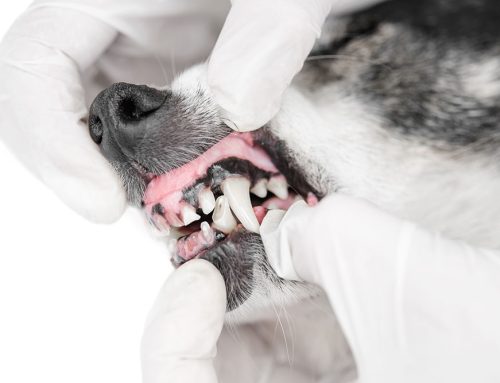Do you know what to do if your dog is limping? Dogs can limp for various reasons. In some cases, the issues resolve themselves, while others require veterinary intervention. Our Peak City Veterinary Hospital team answers frequently asked questions about canine lameness, so you know what to do the next time your dog favors a limb.
Question: How do I know which limb my dog is favoring?
Answer: Sometimes you can easily tell which limb your dog is favoring, but you may have a difficult time determining the painful leg if your dog’s lameness is mild. The following information should help.
- Front limb lameness — If your dog favors a front limb, they will raise their head when the painful leg is on the ground and lower their head when the good limb is bearing weight.
- Hind limb lameness — If your dog favors a hind limb, their hip and tail will elevate when they put the painful leg on the ground.
If your dog has multiple painful limbs, you likely won’t notice an obvious limp, but they may exhibit an odd gait or seem stiff.
Question: Why is my dog limping?
Answer: Numerous conditions can cause your dog to limp. Some common reasons include:
- Bone fractures — Fractures commonly cause dogs to limp. Severity depends on the trauma extent.
- Torn nails — Torn nails can be extremely painful—and extremely bloody—for your canine friend, especially if the sensitive quick is exposed.
- Paw injuries — Your dog’s paws are vulnerable to many injuries, including lacerations, puncture wounds, and burns.
- Arthritis — Arthritis is common in dogs, especially senior canines. In addition to a limp, arthritis signs include stiffness after resting, resting in awkward positions, difficulty navigating stairs, hesitancy when jumping on or off elevated surfaces, and decreased interest in activities.
- Hip dysplasia — Hip dysplasia is an orthopedic developmental disorder that causes a loose hip joint. Large-breed dogs, such as German shepherds, Labrador retrievers, and golden retrievers, are at increased risk.
- Elbow dysplasia — Elbow dysplasia is an orthopedic developmental disorder caused by several elbow growth abnormalities. Breeds at increased risk include Bernese Mountain dogs, German shepherds, and golden retrievers.
- Cranial cruciate ligament (CCL) injuries — CCL injuries are one of the most common causes of hind limb lameness in dogs. This degenerative condition can affect young, athletic dogs, but most commonly is seen in older dogs. Breeds at increased risk include rottweilers, golden and Labrador retrievers, boxers, and Newfoundlands.
- Tick borne disease — Tick-borne diseases, such as Lyme disease, ehrlichiosis, and Rocky Mountain spotted fever, can cause joint inflammation, leading to lameness.
- Cancer — Osteosarcomas and other cancers affecting limbs and joints can result in lameness.
- Intervertebral disc disease (IVDD) — Dogs with IVDD may experience limb weakness, which can manifest as a limp.
Question: How do I know if my dog’s limp requires veterinary care?
Answer: If your dog has only a mild limp, you should monitor them for two to three days to see if the issue resolves, and then schedule a regular veterinary examination if they continue to limp. Signs that indicate your canine friend requires emergency veterinary care include:
- Trauma — If your dog experienced a significant trauma, such as being hit by a car or falling from a high elevation, they need immediate veterinary care.
- Dog fight — If your dog is limping after a dog fight, they may have sustained a dog bite and should be evaluated by a veterinarian as soon as possible.
- Obvious fracture — If your dog has an obvious fracture or dislocation, they need emergency veterinary care to stabilize the limb and provide pain relief.
- Bleeding — If your dog is bleeding excessively (i.e., copious blood or bleeding that doesn’t stop after five minutes), they need emergency veterinary care.
- Extreme pain — If your dog is in extreme pain (i.e., they are vocalizing, trembling, refusing to eat or move, or exhibiting aggression), they should be evaluated by a veterinarian as soon as possible.
- Other signs — If your dog is exhibiting signs such as lethargy, fever, vomiting, difficulty breathing, or disorientation, they need emergency veterinary care.
- Limb dragging — If your canine friend drags a limb, they require immediate veterinary care.
Question: How will my dog’s lameness be diagnosed?
Answer: Diagnostics we may use to assess your dog’s lameness include:
- Physical examination — Our team will thoroughly examine your dog, including watching their gait and palpating their limbs and joints.
- Blood work — In some cases, we may need blood work to assess your canine friend’s overall health.
- X-rays — X-rays may be necessary to evaluate your dog’s bones and surrounding structures.
Question: How will my dog’s lameness be treated?

Answer: Your dog’s treatment will depend on the lameness cause. Our team will devise an appropriate treatment strategy that may involve:
- Rest — In some cases, confining your dog so they don’t run and jump can resolve lameness.
- Pain medication — Pain medications, such as non-steroidal anti-inflammatories, will sometimes alleviate your dog’s discomfort while they heal.
- Antibiotics — If a tick-borne illness or other infection is causing your dog’s lameness, we may prescribe an antibiotic.
- Surgery — In severe cases, your dog may need surgery to resolve their lameness.
Contact our Peak City Veterinary Hospital team if your dog is limping, so we can get them back on all four legs as soon as possible.









Leave A Comment